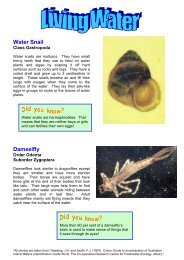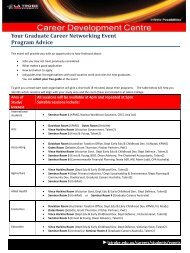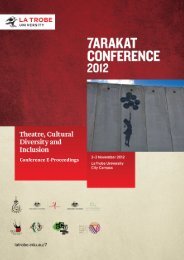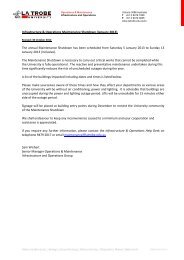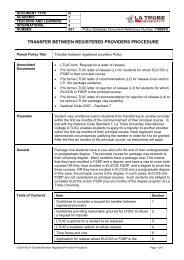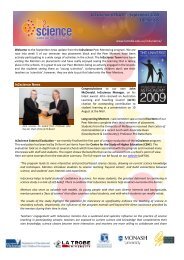Getting Ready to Talk Manual [PDF 315KB] - La Trobe University
Getting Ready to Talk Manual [PDF 315KB] - La Trobe University
Getting Ready to Talk Manual [PDF 315KB] - La Trobe University
You also want an ePaper? Increase the reach of your titles
YUMPU automatically turns print PDFs into web optimized ePapers that Google loves.
GETTING READY<br />
WEBSITE VERSION<br />
Produced by:<br />
D. Karavias<br />
E. Middle<strong>to</strong>n<br />
E. O’Leary<br />
A. Phillips<br />
E. Stewart<br />
A. Trollope<br />
Under the supervision of<br />
S. Butzkueven<br />
N. Faris<br />
T. Serry<br />
TO TALK
1<br />
GETTING READY TO TALK<br />
Introduction pg 2<br />
Positioning pg 3<br />
<strong>Getting</strong> face <strong>to</strong> face pg 4<br />
Making eye contact pg 5<br />
Letting Your Child Lead pg 6<br />
Watching, waiting, listening pg 7<br />
Following your child’s lead pg 8<br />
Joining in pg 9<br />
Using Simple <strong>La</strong>nguage pg 10<br />
Commenting pg 11<br />
<strong>La</strong>belling pg 12<br />
Repeating pg 13<br />
Praising pg 14<br />
Adding one word pg 15<br />
Creating Opportunities for Communication pg 16<br />
Waiting pg 17<br />
Giving choices pg 18<br />
Giving bit by bit pg 19<br />
Interacting With Others pg 20<br />
Turn taking pg 21<br />
Imitating pg 22<br />
Making communication fun pg 23<br />
Using natural gesture pg 24<br />
Sharing Books and Enjoying Song pg 25<br />
Sharing books pg 26<br />
Enjoying song pg 27<br />
Extra Suggestions pg 28<br />
Acknowledgements and References pg 29
2<br />
Introduction<br />
‘<strong>Getting</strong> <strong>Ready</strong> <strong>to</strong> <strong>Talk</strong>’ is an interactive DVD and manual designed <strong>to</strong> help parents<br />
apply speech pathology techniques at home. The images and videos on the DVD match<br />
with the chapters in the manual <strong>to</strong> assist you in understanding how and why an activity<br />
may help your child improve their communication skills.<br />
As you will see in the DVD, many of the clips show a parent and a child playing.<br />
Play is an important <strong>to</strong>ol in helping <strong>to</strong> stimulate communication and language in your<br />
child. Play stimulates a child’s development in a number of ways. Play teaches children<br />
important communication skills such as eye contact, turn taking and understanding<br />
others, while also making learning fun.<br />
The project was produced by fourth year speech pathology students from <strong>La</strong> <strong>Trobe</strong><br />
<strong>University</strong> in conjunction with Western Health.<br />
Note: The terms ‘he’ and ‘she’ are alternated between chapters. This is so the<br />
information is easier <strong>to</strong> read. The techniques are still the same regardless of who you<br />
are doing them with.
3<br />
POSITIONING<br />
<strong>Getting</strong> face <strong>to</strong> face<br />
Making eye contact
<strong>Getting</strong> face <strong>to</strong> face<br />
What is it?<br />
Positioning your body so that you are at your child’s level and face <strong>to</strong> face.<br />
Why is it important?<br />
Being face <strong>to</strong> face allows your child <strong>to</strong> watch you closely. Your child can see your mouth<br />
movements and your facial expressions. This makes it easier for her <strong>to</strong> understand you.<br />
Being at your child’s level also helps you <strong>to</strong> share in her play.<br />
How?<br />
Try things like:<br />
• Facing your child;<br />
• Being at the same level as your child, e.g. if she is on the floor, you go on the<br />
floor <strong>to</strong>o;<br />
• Making sure you can see each others faces.<br />
Example:<br />
Child is sitting on the floor playing with blocks.<br />
Parent: Sits down in front of child. Now the child and the parent are at the<br />
same level and can see each others faces.<br />
4
Making eye contact<br />
What is it?<br />
Making eye contact occurs when you and your child look at each other’s eyes.<br />
Why is it important?<br />
Making eye contact is very important when communicating with people. It can be just as<br />
important as using words. Eye contact shows your child that you are ready and want<br />
communicate with her.<br />
How?<br />
There are many ways you can do this, including:<br />
● Being at your child’s level and face <strong>to</strong> face;<br />
● Holding a desired object (e.g. a <strong>to</strong>y) at eye level;<br />
● Saying your child’s name <strong>to</strong> attract her attention;<br />
● Using an animated voice <strong>to</strong> encourage your child <strong>to</strong> look at you.<br />
Example:<br />
Parent and child are sitting on the floor facing each other rolling a ball.<br />
Parent: Catches the ball and brings it <strong>to</strong> eye level.<br />
Child: Looks in direction of the ball and makes eye contact with the parent.<br />
Suggestion:<br />
If your child finds it hard <strong>to</strong> sit still facing you, try sitting facing a mirror with your child in<br />
your lap. This way you can make eye contact in the mirror.<br />
5
6<br />
LETTING YOUR CHILD<br />
LEAD<br />
Watching, waiting, listening<br />
Following your child’s lead<br />
Joining in
Watching, waiting, listening<br />
What is it?<br />
• Noticing where your child is looking and what he is looking at (watching)<br />
• Waiting for your child <strong>to</strong> start playing or interacting with you (waiting)<br />
• Listening <strong>to</strong> any sounds or words your child makes (listening).<br />
Why is it important?<br />
This helps you learn how your child communicates and what he is interested in. Once<br />
you know this you can provide your child with lots of opportunities <strong>to</strong> communicate with<br />
you.<br />
How?<br />
Watching:<br />
• Look in the same direction as your child;<br />
• Notice what your child is looking at;<br />
• Look at your child’s gestures, actions and facial expressions.<br />
Waiting:<br />
• Watch your child and wait for him <strong>to</strong> communicate.<br />
Listening:<br />
• Listen for any sounds or words your child uses;<br />
• Wait for your child <strong>to</strong> finish communicating before you speak.<br />
Example:<br />
Parent and child playing in the park.<br />
Child: Walks <strong>to</strong> the swing and looks at parent.<br />
Parent: Watches, waits and listens, and discovers the child wants a turn on<br />
the swing.<br />
7
Following your child’s lead<br />
What is it?<br />
Following your child’s lead means allowing your child <strong>to</strong> choose what he plays with and<br />
how he plays with it.<br />
Why is it important?<br />
It is important <strong>to</strong> know what <strong>to</strong>ys or games your child is interested in. Playing games<br />
that your child likes helps <strong>to</strong> keep him interested. The longer you play games <strong>to</strong>gether,<br />
the more opportunity you have <strong>to</strong> communicate with each other.<br />
How?<br />
Try the following:<br />
• Let your child choose what he plays with;<br />
• Let your child decide how he wants <strong>to</strong> play;<br />
• Try <strong>to</strong> join in and play the same way your child is playing;<br />
• It is fine if your child does not play the ‘right’ way. Try and copy what ever he is<br />
doing.<br />
Example:<br />
The child is playing with pots and pans from the cupboard.<br />
Child: Starts banging a spoon on the pots.<br />
Parent: Picks up a spoon and starts banging a pot.<br />
Parent: “Bang, bang, bang. Noisy!”<br />
8
Joining in<br />
What is it?<br />
Joining in simply means getting involved in your child’s play. It could be:<br />
● Playing with each other;<br />
● Playing with the one <strong>to</strong>y <strong>to</strong>gether;<br />
● Playing with similar <strong>to</strong>ys at the same time.<br />
Why is it important?<br />
Joining in with your child’s play creates an opportunity for communication. Playing the<br />
same game allows you <strong>to</strong> communicate about the same thing.<br />
How?<br />
Try things like:<br />
• Watching how your child plays with a <strong>to</strong>y and copying him;<br />
• Playing with the <strong>to</strong>y in a different way and using comments <strong>to</strong> tell him what you<br />
are doing.<br />
Example:<br />
Child is playing with playdough.<br />
Parent: Joins in by starting <strong>to</strong> roll the playdough.<br />
Child: Puts playdough in a cup.<br />
Parent: Parent takes the cup and pretends <strong>to</strong> drink from it.<br />
9
USING SIMPLE LANGUAGE<br />
10<br />
Commenting<br />
<strong>La</strong>belling<br />
Repeating<br />
Praising<br />
Adding one word
Commenting<br />
What is it?<br />
Commenting involves using short but complete phrases <strong>to</strong> talk about what your child is<br />
doing or looking at.<br />
Why is it important?<br />
Commenting lets your child hear the words that describe what she is interested in.<br />
When you comment on what your child is doing, your child hears correctly used words<br />
and phrases. Using comments instead of asking questions puts less pressure on your<br />
child <strong>to</strong> talk.<br />
How?<br />
You can comment in any situation. Try:<br />
• Looking at what your child is doing and describing it;<br />
• Looking at what your child is interested in and describing it;<br />
• Using short phrases;<br />
• Commenting on your own actions;<br />
• Using more comments than questions.<br />
Example:<br />
Child is having a bath.<br />
Child Washes her face.<br />
Parent: “Wash, wash, wash, you’re washing your face.”<br />
11
<strong>La</strong>belling<br />
What is it?<br />
<strong>La</strong>belling is saying the name of an object or action.<br />
Why is it important?<br />
<strong>La</strong>belling helps your child <strong>to</strong> learn new words. Your child needs <strong>to</strong> hear words before<br />
she can use them. It is better <strong>to</strong> tell your child what something is rather than asking her.<br />
Telling your child the names for lots of things helps <strong>to</strong> build her vocabulary.<br />
How?<br />
Try the following:<br />
• <strong>La</strong>bel objects your child is interested in;<br />
• Point <strong>to</strong> or hold the object when you label it;<br />
• Use an excited voice and repeat the word a few times. There is no need for your<br />
child <strong>to</strong> repeat it back;<br />
• Be specific and use different types of words like:<br />
o Naming words like ‘block’ or ‘cup’;<br />
o Doing words like ‘jumping’ or ‘skipping’;<br />
o Describing words like ‘wet’ or ‘fast’.<br />
Example:<br />
Parent and child are playing trains.<br />
Child: Starts pushing a train on the train tracks.<br />
Parent: “Train” (points <strong>to</strong> the train).<br />
12
Repeating<br />
What is it?<br />
Repeating involves saying a word or a phrase more than once.<br />
Why is it important?<br />
Repeating helps your child <strong>to</strong> learn specific words and parts of language. Your child<br />
needs <strong>to</strong> hear words many times before she will use them. Repetition is very important<br />
for learning more about talking and language<br />
How?<br />
Try the following suggestions:<br />
• Repeat words during activities anywhere at anytime;<br />
• Repeat a word if your child uses it.<br />
Example:<br />
Parent and child are playing during bath time.<br />
Child Splashes the bath water.<br />
Parent: “Splash, splash, splash.”<br />
13
Praising<br />
What is it?<br />
Praising is giving a positive reward for your child’s attempts at communicating.<br />
Why is it important?<br />
It is important <strong>to</strong> praise your child for all attempts at communication. Children enjoy<br />
being praised. Praise is very simple for parents <strong>to</strong> do. It helps encourage your child <strong>to</strong><br />
keep practicing her communication.<br />
How?<br />
When your child communicates:<br />
• Use spoken praise such as “great talking” or “good asking” when your child<br />
attempts <strong>to</strong> communicate. It does not matter if your child does not say something<br />
perfectly;<br />
• Try using different types of praise with your child;<br />
• Use an excited voice when praising;<br />
• Give your child a hug, smile or tickle;<br />
• Respond with further talking <strong>to</strong> your child. This will show your child that<br />
communicating is fun AND useful;<br />
• Praise all types of communication (talking, gesture, eye contact).<br />
Example:<br />
Parent and child are playing with a ball.<br />
Child: Points <strong>to</strong> the ball.<br />
Parent: “Ball.”<br />
Child: “Ba.”<br />
Parent: “Yes, ball!” Great talking.”<br />
14
Adding one word<br />
What is it?<br />
Adding one word is when you add one word <strong>to</strong> what your child has said.<br />
Why is it important?<br />
This is important for teaching your child new words and expanding her language. It also<br />
teaches your child how <strong>to</strong> join words <strong>to</strong>gether.<br />
How?<br />
To know how many words <strong>to</strong> say try the following:<br />
• Watch and listen - is your child using a gesture or a word?<br />
• If your child uses a gesture say the matching word;<br />
• If your child says one word, repeat the word and add one more.<br />
Example 1: Child uses no words<br />
Parent and child are bouncing a ball.<br />
Child: Bounces the ball and looks at the parent (uses no words).<br />
Parent: “Bounce”<br />
(adds one word).<br />
Example 2: Child uses one word<br />
Parent and child are bouncing a ball.<br />
Child: Bounces the ball, “bounce” (uses one word).<br />
Parent: “Ball bounce” (adds one word).<br />
15
CREATING OPPORTUNITIES<br />
16<br />
FOR COMMUNICATION<br />
Waiting<br />
Giving choices<br />
Giving bit by bit
Waiting<br />
What is it?<br />
Waiting for the child <strong>to</strong> communicate what he wants.<br />
Why is it important?<br />
Waiting helps your child understand the importance of communicating <strong>to</strong> get his needs<br />
and wants met. Your child also gets a chance <strong>to</strong> practice communicating.<br />
How?<br />
Use the following suggestions:<br />
• Choose an object your child is interested in;<br />
• Try using favourite <strong>to</strong>ys, food or drinks;<br />
• Place the object in view, but just out of reach;<br />
• Wait for your child <strong>to</strong> ‘ask’ for the object;<br />
• Asking can be a look, gesture, sound or word;<br />
• If he ‘asks’ with a gesture, say the matching word;<br />
• If he ‘asks’ with a word, add one more;<br />
• Give your child the object;<br />
• This is a great technique <strong>to</strong> try during snack time.<br />
Example:<br />
Parent and child are sitting at the table having a drink.<br />
Parent: Places the drink just out of reach and waits.<br />
Child: Looks at the drink and reaches.<br />
Parent: “Drink. Good looking!” (Parent gives the child the drink).<br />
17
Giving choices<br />
What is it?<br />
Giving choices is offering your child a choice between two objects.<br />
Why is it important?<br />
Giving choices helps you teach words for things your child wants. It also encourages<br />
your child <strong>to</strong> communicate and <strong>to</strong> ‘ask’ for something. This is an important skill.<br />
How?<br />
Try the following:<br />
• Choose two objects that your child is interested in;<br />
• Hold both objects and label each one for your child;<br />
• Wait for your child <strong>to</strong> ‘ask’ (asking can be a look, gesture, sound or word);<br />
• Give your child the object and repeat the matching word;<br />
• Try using food, favourite <strong>to</strong>ys or favourite books;<br />
• You can give choices in everyday activities, like snack time.<br />
Example:<br />
Parent and child are eating a snack <strong>to</strong>gether.<br />
Parent: Holds a piece of fruit in each hand.<br />
Parent: “Apple (shows apple) or orange (shows orange and waits).”<br />
Child: Looks and reaches for the apple.<br />
Parent: “Apple. Good asking!”<br />
18
Giving bit by bit<br />
What is it?<br />
Giving your child something a little bit at a time and practising communication.<br />
Why is it important?<br />
It allows your child <strong>to</strong> have lots of chances at practicing communication.<br />
How?<br />
Try choosing something your child is interested in:<br />
• Place all the pieces in your lap;<br />
• Hold up one piece and label it;<br />
• Wait for your child <strong>to</strong> ‘ask’ (asking can be a look, gesture, sound or word);<br />
• Give your child the object and repeat the matching word;<br />
• Offer the next piece.<br />
Example:<br />
Parent and child are building a train track:<br />
Parent: Puts the pieces of the train track in their lap.<br />
Parent: “Track” (hold one piece of the track and waits for the child <strong>to</strong> ‘ask’).<br />
Child: Gestures <strong>to</strong> the track.<br />
Parent: Gives the train track <strong>to</strong> the child immediately and says “track.”<br />
Parent: “More?” (Holds the next piece in view and waits for the child <strong>to</strong> ‘ask’).<br />
Suggestions:<br />
Try this technique with <strong>to</strong>ys that have lots of pieces. For example, shape sorters,<br />
puzzles, train sets and building blocks. Also try it with food at snack time (see above<br />
example).<br />
19
INTERACTING WITH OTHERS<br />
20<br />
Turn taking<br />
Imitating<br />
Making communication fun<br />
Using natural gesture
Turn taking<br />
What is it?<br />
Turn taking is an important skill for communicating. We all have <strong>to</strong> take turns when we<br />
communicate with someone.<br />
Why is it important?<br />
It is important <strong>to</strong> take turns when playing games and when talking. Practising both types<br />
of turn taking helps your child understand the rules of communication.<br />
How?<br />
Play games with your child where you both take turns:<br />
• Keep the routine the same;<br />
• Give your child a clear cue when it is her turn;<br />
• Remember <strong>to</strong> watch and wait,<br />
sometimes your child needs time <strong>to</strong> take her turn;<br />
• Your child may use an action, gesture, sound or word as her turn.<br />
Example:<br />
Parent and child are playing with a hat.<br />
Child: Puts the hat on the parents head.<br />
Parent: (Knocks hat off) “Fall down!”<br />
Parent: Puts hat on child’s head.<br />
Child: Knocks hat off.<br />
Parent: “Fall down!”<br />
Suggestions:<br />
Try playing games like rolling a ball, blowing bubbles, putting shapes in a shape sorter<br />
or putting pieces in a puzzle.<br />
21
Imitating<br />
What is it?<br />
Imitation involves doing the same thing that your child is doing. Copy what your child<br />
says or what your child does.<br />
Why is it important?<br />
Imitating your child’s words reinforces what she is saying and shows your child that you<br />
are listening. Imitating actions is a good way <strong>to</strong> involve yourself in your child’s play.<br />
When you are involved you can create opportunities for communication.<br />
How?<br />
Try the following:<br />
• Observe what your child is doing;<br />
• Play with a <strong>to</strong>y the same way as your child;<br />
• Copy any words or sounds you hear your child say;<br />
• Copy any actions your child does.<br />
Example:<br />
Parent and child are playing with a tea set.<br />
Child: Brings cup of tea <strong>to</strong> her mouth and sips.<br />
Parent: Imitates by bringing a cup <strong>to</strong> mouth and sipping.<br />
Parent: “Drink.”<br />
22
Making communication fun<br />
What is it?<br />
Using facial expressions, vocal <strong>to</strong>nes and gestures when you are talking <strong>to</strong> make<br />
communication fun.<br />
Why is it important?<br />
Making communication exciting and interesting encourages your child <strong>to</strong> communicate.<br />
How?<br />
To make communication fun try:<br />
• Speaking with an excited voice when you are talking <strong>to</strong> your child;<br />
• Using phrases such as “Oh no!”, “Well done!”, “Uh oh!” and “Yay!”<br />
• Using an excited face and big smiles;<br />
• Using big gestures when playing games with your child.<br />
Example<br />
Parent and child are playing peek-a-boo.<br />
Child: Puts hands in front of her face.<br />
Parent: (Opens mouth wide and uses an excited <strong>to</strong>ne of voice) “Where has he<br />
gone?!”<br />
23
Using natural gesture<br />
What is it?<br />
Using a natural gesture when you say a word.<br />
Why is it important?<br />
Using gestures helps your child understand what you are saying. It makes words fun<br />
and the meaning clearer.<br />
How?<br />
When adding gestures try:<br />
• Saying a word and using a gesture at the same time;<br />
• Using gestures that match important words you saying.<br />
Example:<br />
Parent and child are blowing bubbles.<br />
Child: Pops all the bubbles.<br />
Parent: Shrugs shoulders and raises arms and hands up.<br />
Parent: “All gone!”<br />
24
25<br />
SHARING BOOKS AND<br />
ENJOYING SONG<br />
Sharing books<br />
Enjoying song
Sharing books<br />
What is it?<br />
Sharing books involves looking at and talking about books with your child.<br />
Why is it important?<br />
Sharing books and talking about the pictures helps your child learn new words in a fun<br />
way.<br />
How?<br />
Try the following suggestions:<br />
• Choose a quiet place <strong>to</strong> sit;<br />
• Start the book where your child wants and turn the pages when he is ready;<br />
• Use short phrases <strong>to</strong> talk about the pictures;<br />
• Comment on the pictures your child is looking at;<br />
• <strong>La</strong>bel different pictures rather than reading the words;<br />
• Repeat the words you say and use natural gestures;<br />
• Make it fun by using an excited voice.<br />
Example:<br />
Parent and child are looking at ‘Spot’ <strong>to</strong>gether.<br />
Child: Points <strong>to</strong> Spot.<br />
Parent: “Look, there’s Spot!”<br />
Child: “WOOF!”<br />
Parent: “Woof, woof, Spot’s barking.”<br />
Suggestions:<br />
You can share books everywhere. For example, in the bath, sitting in bed, or in a<br />
highchair. Interactive books are very interesting for young children. These include books<br />
with flaps, pop-up pictures or textured pages.<br />
26
Enjoying song<br />
What is it?<br />
Singing songs with your child.<br />
Why is it important?<br />
Singing songs encourages interaction and teaches your child new language.<br />
How?<br />
• Position your body so that you are face-<strong>to</strong>-face with your child;<br />
• Use excited faces and an excited voice when singing;<br />
• Use actions that match the words in the song;<br />
• Try pausing and waiting for your child <strong>to</strong> finish a line;<br />
• Sing songs about what you are doing, for example getting dressed.<br />
Example:<br />
Parent and child are singing “Old MacDonald.”<br />
Parent: “...and on that farm he had some...(pause)”<br />
Child: “Sheep.”<br />
Parent: “E-I-E-I-O. With a...(pause).”<br />
Child: “Baaaaaa baaaa.”<br />
Suggestions:<br />
Songs like ‘Old MacDonald’, are great for repetition of words and language. Interactive<br />
songs like ‘Row row row your boat’ are fun and fast. Sit your child on your lap, hold<br />
hands and move backwards and forwards whilst singing.<br />
27
Extra suggestions<br />
If your child likes <strong>to</strong> move around a lot or can’t sit still for very long, the following<br />
suggestions may be helpful. Some things will work better than others for your child:<br />
28<br />
• Use <strong>to</strong>ys and games that your child is very interested in.<br />
• Play games where you can move around <strong>to</strong>gether. For example tickling, jumping<br />
and throwing games.<br />
• Keep activities short. If your child is losing interest, let him choose a new activity.<br />
• Have a few different activities set up.<br />
• Show lots of excitement when playing. This makes activities more interesting.<br />
• Sit your child in your lap.
29<br />
ACKNOWLEDGMENTS AND REFERENCES<br />
The authors of this manual would like <strong>to</strong> thank the following people for their generous<br />
contributions <strong>to</strong> this project:<br />
Sally Butzkueven and Nikol Faris<br />
Tanya Serry<br />
The families involved in filming<br />
Children’s Allied Health Service Western Heath<br />
<strong>La</strong> <strong>Trobe</strong> <strong>University</strong><br />
Ethan Bot<strong>to</strong>mley<br />
Yen Le<br />
Will Gaffney<br />
Bart Strzebonski and Tim Price<br />
References:<br />
Berryman, J., Smythe, P., <strong>La</strong>mont, A., & Joiner, R. (2002). Developmental psychology<br />
and You. (2nd ed.). Oxford: BPS Blackwell.<br />
Owens, R. (2008). <strong>La</strong>nguage Development, An Introduction. (7th ed.). Bos<strong>to</strong>n:<br />
Pearson Education, Inc.<br />
Paul, R. (2007). <strong>La</strong>nguage disorders: From infancy through adolescence. (3rd ed.).<br />
Missouri: Mosby Elsevier.<br />
Sussman, F. (1999). More than words: Helping parents promote communication and<br />
social skills in children with autism spectrum disorder. Toron<strong>to</strong>: The Hanen Centre.<br />
Western Health. (07/2011). Week three handouts. Sunshine: Western Health.


![Getting Ready to Talk Manual [PDF 315KB] - La Trobe University](https://img.yumpu.com/11430807/1/500x640/getting-ready-to-talk-manual-pdf-315kb-la-trobe-university.jpg)
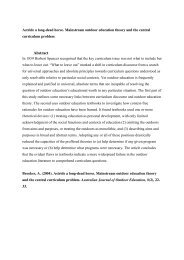


![Ottoman Empire course brochure [PDF 612KB] - La Trobe University](https://img.yumpu.com/12001562/1/184x260/ottoman-empire-course-brochure-pdf-612kb-la-trobe-university.jpg?quality=85)
